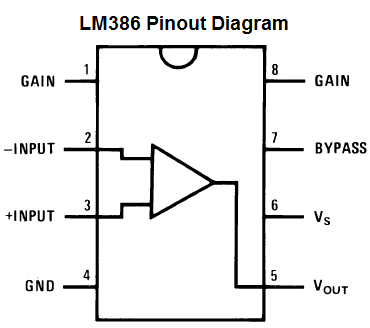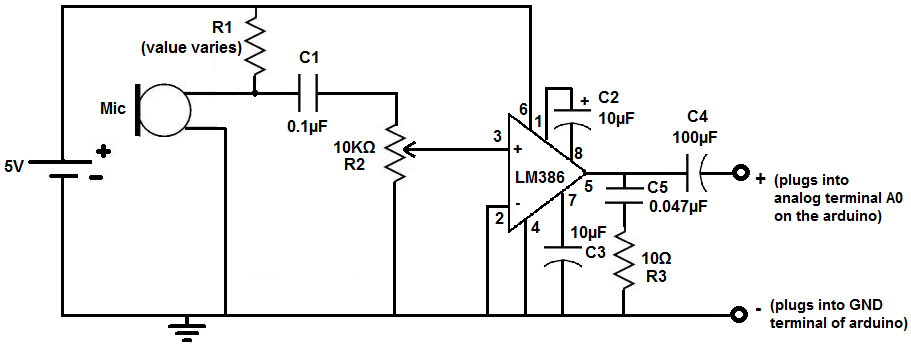How to Build a Microphone Amplifier Circuit

In this project, we will go over how to connect a microphone to an amplifier circuit so that we can amplify the sounds recorded by the microphone.
This way, if the signals recorded by the microphone are too faint or low, we can provide decent amplification to them so that they can be larger and thus more easily detected.
This is necessary for a wide variety of applications, because many microphones record only with small electrical signals. These signals, alone, would not be great enough to be detected. Thus, it is important to connect them to an amplifier to provide gain. The amplifier also gives the added benefit in that you can connect them to vary the level of the gain, meaning you can provide volume control, which we will do in this circuit.
The amplifier IC we will use in this circuit is the popular LM386 IC. This is a low-power audio amplifier Chip.
We explain in detail how to use this chip.
Components Needed for Microphone Amplifier Circuit
- A Microphone
- 6 Volts of power (either from 4 'AA' batteries or a DC power supply)
- 2KΩ-6KΩ resistor (depending on the microphone in use)
- 10Ω resistor
- 10KΩ potentiometer
- 2 10μF electrolytic capacitor
- 100μF electrolytic capacitor
- 0.1μF ceramic capacitor
- 47nF ceramic capacitor
- 3.5mm audio plug
Microphones, resistors, capacitors, and the LM386 audio amplifer chip can be easily obtained from most electronic online retailers. You can really use any type of microphone.
Before we show the complete schematic diagram of the microphone amplifier circuit, we will first show the pinout of the LM386. This way, the connections that we make from the microphone to it will make more sense.
The pinout diagram is shown below:

Pin Terminals
Terminals 1 and 8 represent the gain control of the amplifier. These are the terminals
where you can adjust the gain by placing a resistor and capacitor or just capacitor between these
terminals. In this circuit, we will place a 10µF capacitor between these terminals for the highest voltage gain. You can adjust
this as necessary to adjust the gain, as needed.
Terminals 2 and 3 are the sound input signal terminals. These are the terminals where you place
the sound which you want to amplify. In our case for this circuit, the condenser microphone will be connected to these terminals.
Terminal 2 is the -input and Terminal 3 is the +input. In our circuit,
the positive microphone terminal will be placed on terminal 3 and terminal 2 will be connected to the negative microphone terminal, tied to ground.
Terminal 4 is GND (ground). This is where the negative voltage of the power source connects to.
Terminal 5 is the output of the amplifier. This is the terminal in which the amplified sound signal comes out.
Terminal 6 is the terminal which receives the positive DC voltage so that the op amp can receive
the power it needs to amplify signals.
Terminal 7 is the Bypass terminal. This pin is usually
left open or is wired to ground. However, for better stability, a capacitor is added in our circuit because this can prevent
oscillations in the amp chip.
LM386 Amplifier Circuit
Now that you what each of the pins of the LM386 represents, we can assemble the whole audio amplifier circuit.
The schematic for the amplifier part of the circuit is shown below:

R1 is a resistor that connects the microphone to positive voltage so that the microphone is able to power on. Microphones cannot work without the necessary power needed. The value of the resistor is variable because it depends on the specific microphone that you have in use. Check the datasheet of the microphone you are using to find out the most suitable value for the necessary pull-up resistor.
C1 is a capacitor that blocks DC voltage on the input signal and allows AC to pass through. When we speak into a microphone, our voice or music is the AC signal. This is the only part of the signal that we want to pass through to output. The DC signal is only used to give power to the microphone; we do not want it to appear in output. This is why we use this capacitor. It blocks the DC but allows the AC to go into output.
R2 is a potentiometer that is used to control the sound volume.
C2 is a capacitor that sets the voltage gain of the LM386 amplifier. Therefore, the voltage out is 200 times the voltage in. This provides us with the maximum gain that the LM386 can provide.
C3 is a capacitor that improves the stability of the LM386 amplifier to prevent issues such as oscillations. Oscillation can distort sound signals, making them unclear or unintelligible.
C4 is a capacitor that removes any DC offset from the output of the LM386 amplifier.
C5 is a capacitor that acts as a current bank for output. This capacitor drains when sudden surges of current occur and refills with electrons when the demand
for current is low.
The circuit starts with the microphone. The microphone picks up sound signals and transforms them into electrical signals. These electrical signals are then amplified by the LM386 IC. These signals are then output through pin 5 of the amplifier IC. Now the signal can be made to do with whatever you want to do with them, such as input into a a computer to record with an audio recording software. It can be input into an arduino so that a circuit can react to sound and trigger another electrical component if sound is detected.
If we add a 3.5mm audio plug to our circuit so that the tip of the jack connects to the positive terminal of the output of our circuit and the ground of the jack connects to the ground of the circuit and plug it into a computer, we will be able to do recordings on a computer, just as if we had a professional microphone.
The following is the recording obtained from plugging this circuit into a computer and doing an audio recording:
Microphone Amplifier Circuit- Test Recording
To see a demo of this circuit in real life, see the video below.
Related Resources
How to Drive a 7 Segment LED Display with an Arduno
How to Build a Dark-activated Light Circuit
How to Build a Hall Effect Sensor Circuit
How to Build a Touch Sensor Circuit
How to Build an Accelerometer Circuit
How to Build a Motion Detector Circuit
How to Build a Motion Detector Alarm Circuit
